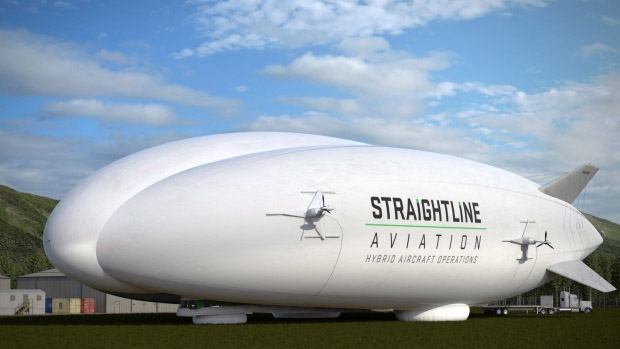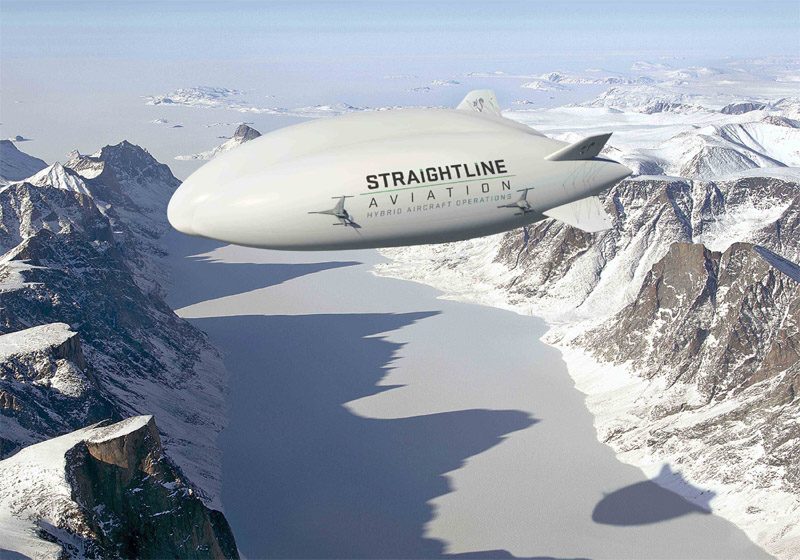  
2021/6/20
Transportation
Straightline Airships: Environment-friendly commercial aviation that requires no roads or airports

WT staff
Interview with Mark Dorey, CEO, Straightline Aviation, June 17, 2021.
WT – Thanks for doing this Mark.
Dorey – No problem. Pleasure.
WT – When you say Straightline Aviation, what does that mean to someone in Canada? Your business is centered on airships and I’m hoping you can tell us a little bit about the business and the background.
Dorey – Yeah, for sure. We’ve been in the airship business for a long time now. Historically flying airships mainly for advertising purposes that you have seen flying around North America, US and Canada over the years.
We’ve been very interested in the development in the new hybrid airship technology for heavy lift and remote transport solutions and have been working on that now for a number of years with some of the major OEM’s. We’re poised now to scale up and are moving towards deployment of the commercial aircraft in the forthcoming years.
Canada is an important market, mostly a lot of Canada is difficult to access through conventional transport, so we believe that the new generation of hybrid airships has a great role to play in some of the logistic problems that are faced by remote communities.
WT – Can you tell our viewers what is a hybrid airship? I’ve known about airships since I’ve read Jules Verne but I’m not 100 percent sure what hybrid means.
Dorey – Of course. Most airships traditionally have been lighter than air which gives problems for weight transference when you’re loading and offloading cargo. So, typically they require a mast to moor to, they need a large crew in order to handle the airship on the ground.
A hybrid airship is heavier than air. Its named hybrid because it gets its lift from a variety of different places. It gets a lift as with a traditional airship from the helium staying in the envelope, but it also gets lift from the aerodynamic shape of the envelope and the vector thrust of the engines, so that means it can fly heavier-than-air rather than lighter than air and that in turn helps to manage the unloading and offloading of cargo and/or people. It’s a real breakthrough in terms of technology in utilizing airships for large scale, heavy lift operations.
WT – When you say heavy lift, what does that mean exactly?
Dorey – The payload around 20 tonnes, so you know it's up there with a 737, capable of carrying large cargo volumes and more weight than a helicopter.
WT – That’s amazing. In terms of the Canadian market, we’ve watched the drones sort of rise up as a market segment for some years. It took quite a while for Transport Canada to look at everything and go okay, this is a drone road. What’s the process with an airship in our market?
Dorey – Yeah, I mean, really similar to any kind of aircraft to be certified in the market that it's operating in, and then the operations need to be certified, as to the pilots and mechanics who are working the operations. So, the process is very similar. We are a fair way down the line on most fronts. We have a great deal of experience in establishing new operations for airships all over the world, so that’s part of our bread and butter. Essentially, it’s the same process as any aircraft has to go through to show and demonstrate to the aviation authorities that it's safe and that the operator has the correct competencies to operate safely.
WT – You almost can’t go through an airship conversation without talking about the Hindenburg. I was wondering if these are so safe do you have to be close to where the helium is generated or where do you get the helium from and are these airships safe?
Dorey – Yeah absolutely. Unlike the Hindenburg where the envelopes were filled with hydrogen, the airships today are filled with helium which is an inert gas and it puts out fires rather than creating them. Helium is a by-product of the oil and gas industry. It’s mined in the same way as oil and helium is released during that process. There are dedicated helium mines, and they supply the helium requires to the global market.
WT – When I was looking at different airports and then spaceports, for instance in New Mexico, is there something quite different? I’m looking for a way to explain to the audience that docking this, storing it, launching it is a bit different than an airplane or a certainly a rocket. Can you tell us a little bit about what’s needed on site for a blimp-port I suppose?

Dorey – Actually we don’t need anything on site and that’s the beauty of the hybrid airship being heavier than air and also the unique air cushion landing system which is like a hovercraft which allows it to maneuver on the ground without any pre-prepared service. It will land on ice, snow, water, any dirt or unprepared ground.
It can tackle obstacles up to around about a metre around about 3 and a half, 4 feet. So, there’s very little preparation and that’s one of the reasons why it’s such a great aircraft for accessing remote areas because we don’t need the infrastructure that a traditional aircraft would need. It's also capable of vertical take-off and landing as well as a taxi take-off and landing. So, it’s truly a very versatile aircraft that is capable of operating with minimal ground support and infrastructure.
WT – I find this just fascinating. Let me ask a couple more questions. So, this airship essentially has a hovercraft mounted to the bottom, is that the idea?
Dorey – Correct, it actually has three hovercraft pads which we call air cushion landing systems underneath the aircraft mounted to the envelope which enable it to land and to taxi. Then they go into reverse thrust which helps to increase the adhesion to the ground and makes it very stable for unloading and offloading people and cargo.
WT – Like a Formula 1 car, that’s fascinating. How much is one of these things? How fast do they go? Give me a comparison to ok, I have a Hercules aircraft, I can carry this much, I can go over there this fast. Can you give me sort of a big view of this?
Dorey – Yeah absolutely, I think the first thing to say is that they are much more environmentally friendly and greener than other forms of aviation. They have a l lot less fuel because of the helium lift that they gain from the envelope. So, they’re a little bit slower. The cruise speed is around about 60 knots or thereabouts. They carry 20 tonnes which is less than a Hercules but more than a helicopter, so that’s a rough comparison between them.
WT – How much? I understand that there are very specific things around pricing but in general ballpark what are people looking at to have one of these?
Dorey – Roughly the top price If we were to sell one would be around the 42 to 45 million dollar range depending on the exact fit-outs and what they would be used for, and we would happily do that and operate the aircraft for them. We offer a turn-key service whereby we will own the aircraft and then operate the aircraft on behalf of end use customers. So, we will provide the pilot, the crews, the mechanics, and everything else necessary to operate the aircraft and then charter those out to the customers that want to use them.
WT – That’s amazing. So, is there an airship licensing program, pilot program through Transport Canada. How does that work?
Dorey – Not currently, but we have had a number of conversations about this and the idea would be to set up training schools in Canada to train the pilots, the mechanics and again we talked to some of the fly training schools which exist at the moment to gauge because they say there’s a lot of interest in establishing pilot training programs in Canada.
WT – Is insurance a problem?
Dorey – No not really. Again, the aircraft is incredibly safe. We have a very good track record in operating the airships. We have insurers who know and understand the business well, who know and understand us and our credentials and our background well. So, insurance actually is not a problem at all.
WT – When someone asks you as I’m about to, why do you do what you do around airships? You could buy planes, make money, you could do all kinds of ship transport. Why do you do what you do?
Dorey – I think it's our background, it's something I’ve been involved in for many many years and as have the rest of our team. We’ve got Mike Hendricks our CEO and co-founder, one of the pioneers in lighter-than-air aviation. I think this is a real opportunity to deliver environmentally friendly commercial aviation. Our aim is to deliver zero-emissions aviation and I think that’s within our reach using the hybrid and its special abilities. So, it really is an incredible opportunity to be involved in a new technology which is really capable of transforming the way we look at aviation transport and also transforming parts of the world which are currently less connected as they otherwise might be.
WT – Yeah, that’s a story that Canadians know well. Thanks very much for doing this, I appreciate.
|
|
All rights reserved 2025 - WTNY - This material may not be reproduced in whole or in part and may not be distributed,
publicly performed, proxy cached or otherwise used, except with express permission.
|
|